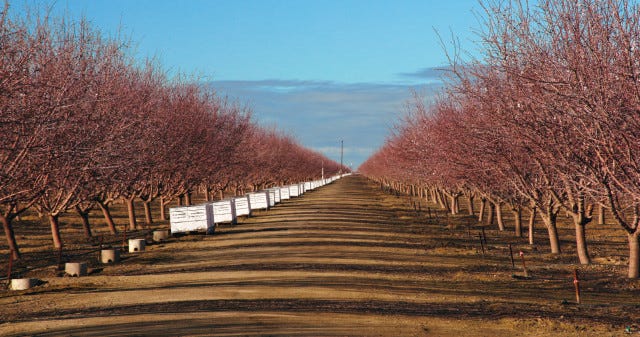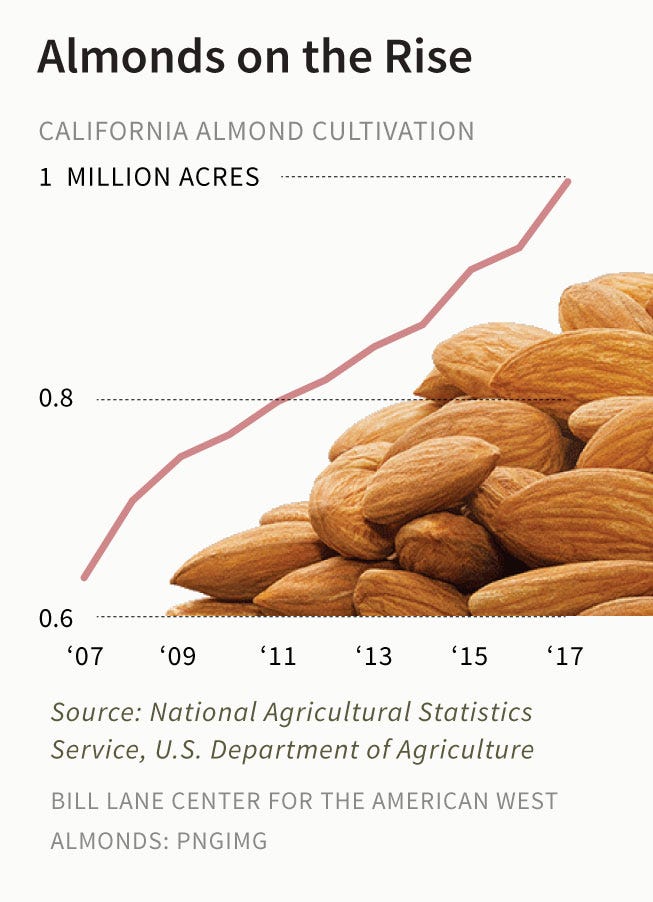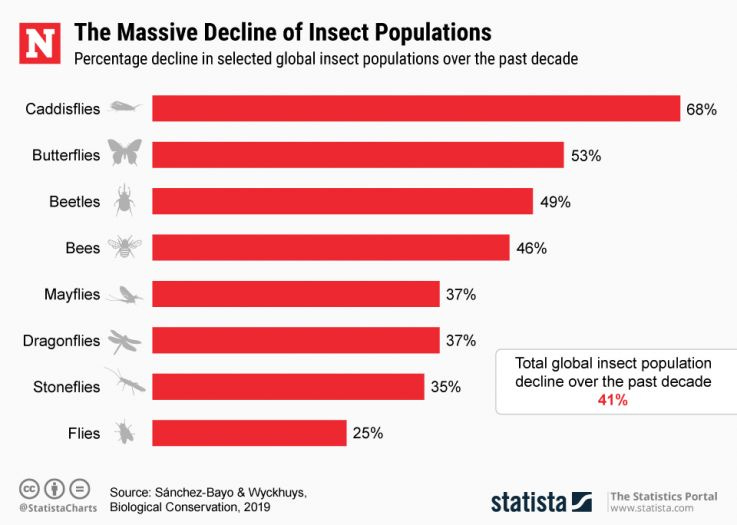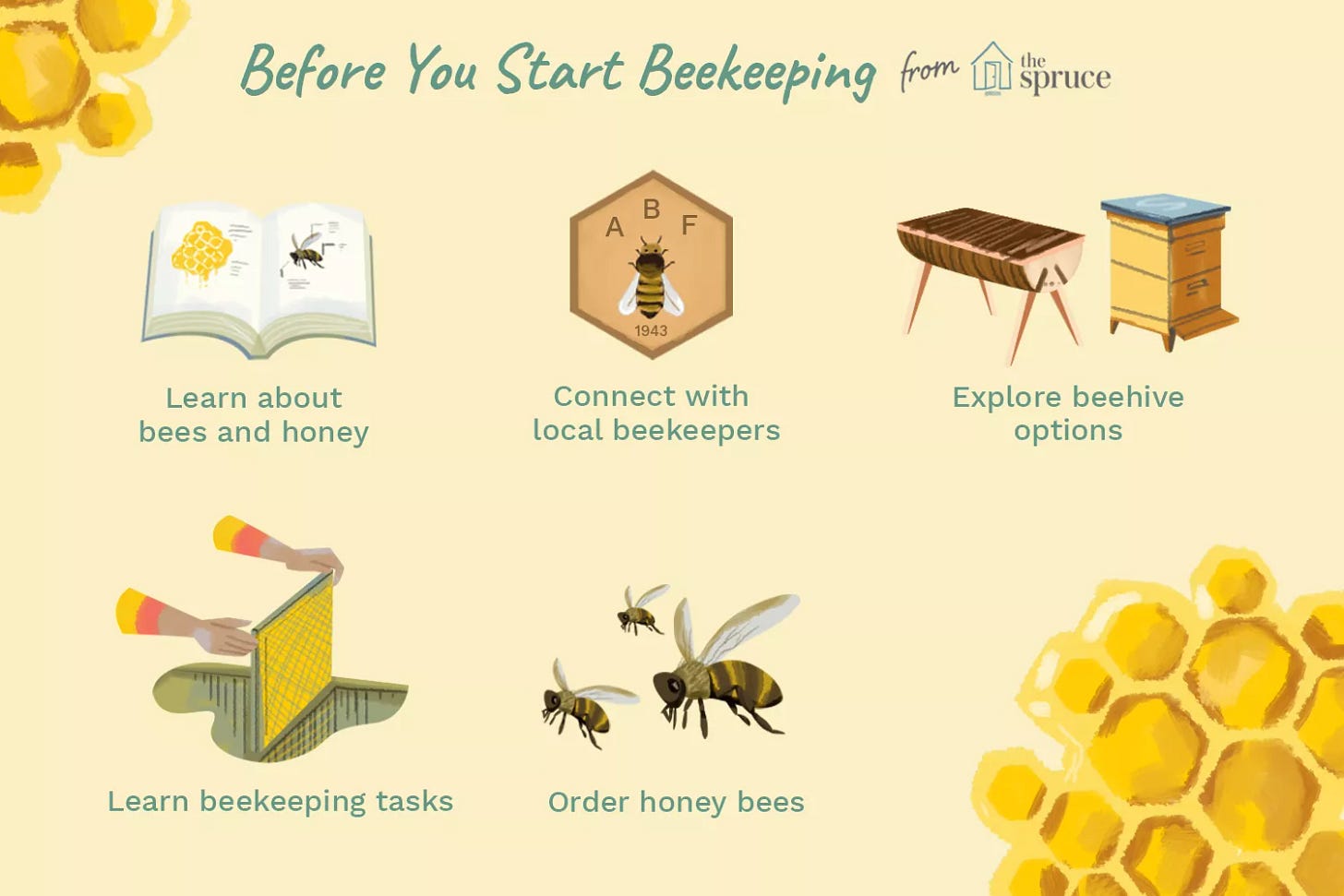~ Welcome to vol21 of #thebalance ~
Happy Sunday ya’ll. After a weekend off in Spain for my 30th, we are back in session.
I was listening to a story on NPR last week that completely fascinated me and, thus, is now serving as the inspo behind this week’s post. The topic: BEES. More specifically covering how important their role (and other pollinators) is in the food (#plants) ecosystem (and just how GD cool of a species they are).

Highlights, include:
🤔🤔 #GetSmart >>> Covering these magical creatures’ crucial role on earth, the current state of the bee union, how important they are for plant-based foods, and the health benefits of honey. #beeautiful (many puns ahead this week)
🎥 🎥 #GetDocu-in’ >>> Highlighting a documentary that is currently doing the rounds on the independent film festival circuit that has been garnering a lot of hype. #thepollinators
🐝 🐝 #GetDoin’ >>> If you are really passionate about saving the bees after this week’s issue, feel free to order your own queen in the mail. Seriously. #beesbeesthemagicalfruit
⬇️ More below ⬇️
_______________________
🚨🚨🚨 EDITOR’S NOTE: There have been reports of this newsletter hittin’ email junk folders. This is no bueno. Please HELP me combat this by adding #thebalance to your email contacts, dragging the email into your inbox (and out of the bulk mail folder), and/or even respond directly to this. THIS WILL HELP ME OUT LOT. THANK YOU :) #badrobots
***Just as a refresher, the core thesis of this newsletter is to pique your curiosity by aggregating interesting topics in a thematic, bite sized, and relevant manner (w/ original posts occasionally) - ranging from blog posts, books, music, events, podcasts, and ideas on how to stay active, travel or otherwise... And please keep sending feedback my way… the goal is to make this thing worth it for you!***
⏩ ⏩ If you like what you see, please share by forwarding (see ‘sign up now’ button) this letter onto your people and/or Tweet out some support!
_______________________
#GetSmart
🤔🤔 Who knew bees were so vital to our survival? Like everything in this world, its all connected (see homeostasis from last week).

>>>> The Great Beescape
Did you know that 1-2 million bees get trucked out to California (~85% of all commercial colonies) each year for #thegreatalmondharvest? … And not only almonds, but also other foods like blueberries, citrus, & squash…. each year, bees ARE VITAL to helping humans avoid a fruit and nut apocalypse.
In 1997, California almonds covered fewer than 500,000 acres. Twenty years later, almond orchards cover more than 1,330,000 acres, up 7% in the last year alone. Today, the state grows more than 80 percent of the world’s supply. Every year, the arrival of the bees to pollinate almond flowers in California orchards – primarily in 5 counties between Los Angeles and the San Francisco Bay Area – marks the start of a brief frenzy of activity. It is the world’s largest pollination event.



In 2017, beekeepers in North Dakota, Idaho, Florida and other states shipped 1.7 million colonies to California to pollinate almond trees, or about 64 percent of the total population as of Jan. 1. The bees travel in semi-truck loads of 400 to 500 colonies each. INSANITY.
So, yes, bees and other pollinators play an important role in the world foodchain, but just how important are they (outside of almond production)?
>>>> Plant Pollination
First things first, bees are not the only important pollinator…. birds, bats, butterflies, beetles, and other insects/ small mammals also pollinate plants that are responsible for bringing us 1 of every 3 bites of food. In addition, they also sustain our ecosystems and produce our natural resources by helping plants reproduce.
🌼🌼Pollinators are animals that move pollen from male structures (anthers) of flowers to the female structure (stigma) of the same plant species. Movement of pollen (analogous to sperm) to a flower’s stigma results in fertilization of the flower’s eggs. An adequately fertilized flower will produce seeds and the fruit surrounding seeds, ensuring that a new generation of plants can be grown.
Pollination is mutually beneficial to plants and to pollinators. Pollination results in the production of seeds and is necessary for many plants to reproduce. Meanwhile, pollinators receive nectar and/or pollen rewards from the flowers that they visit. Sugary nectar provides pollinators with carbohydrates while pollen offers proteins, fats, vitamins, minerals, and necessary phytochemicals. Life cycle illustration below.

According to the US Forest Service, pollinators travel from plant to plant carrying pollen on their bodies in a vital interaction that allows the transfer of genetic material critical to the reproductive system of most flowering plants – the very plants that:
bring us countless fruits, vegetables, and nuts,
½ of the world’s oils, fibers and raw materials;
prevent soil erosion,
and increase carbon sequestration
This nearly invisible ecosystem service is a precious resource that requires attention and support - - and in disturbing evidence found around the globe, is increasingly in jeopardy.
🤯 Without pollinators, the human race and all of earth’s terrestrial ecosystems would not survive. Of the 1,400 crop plants grown around the world, i.e., those that produce all of our food and plant-based industrial products, almost 80% require pollination by animals. 🤯
>>>> Bee (Family) Pollination
In addition to pollen being beneficial to plants, it is also just as beneficial to bees! The bees work together as one cohesive unit to ensure colony survival.

Bees feed on nectar and pollen collected by foragers (older worker bees with beefy flight muscles).
Some foragers gather nectar, which they store in an elastic pouch in the gut known as a “honey stomach”; others collect pollen grains, packing them in “baskets” on their rear legs. Loaded to capacity, foragers return to the colony where nectar-carriers pass their load to “receiver bees” to store as honey, while pollen-bearers offload their hauls into cells to form what’s known as bee bread. “Nurse bees” draw on both to keep the colony fed, and have the job of transforming pollen into royal jelly, which they feed to larvae and to the queen, drones and older worker bees.
>>>> Bees-as-a-business
In the United States alone, pollination of agricultural crops is valued at $10 billion annually. Globally, pollination services are likely worth more than $3 trillion.
Just look at the fees up for grabs for commercial honeybee keepers. Its no wonder these guys flock cross country to pollinate plants in demand given the high demand and $$ at stake #cashcrops

…. These fees are likely to continue to grow, particularly for almonds given there are ~500k resident hives in California and the almond industry needs 2 million to thrive (i.e. two-thirds of the nation’s commercial supply). Almonds’ explosive growth, combined with environmental change, particularly pervasive droughts, have tapped out the supply of hives in the entire West. So almonds draw beekeepers from around the country to earn record high prices per colony.

>>>> Pollinator Pressure
Colony collapse disorder (‘CCD’), according to Wikipedia, is the phenomenon that occurs when the majority of worker bees in a colony disappear and leave behind a queen, plenty of food and a few nurse bees to care for the remaining immature bees.
In the six years leading up to 2013, more than 10 million colonies were lost, often to CCD, nearly twice the normal rate of loss (and its not just bees!! many insects & other pollinators are under threat):

Typical causes are:

BUT BUT BUT, its not all bad news! As of late, beehive loss looks to be stabilizing with the world recently on heightened alert. Although we are not out of the woods yet.
**According to U.N. FAO data, the world's beehive stock rose from around 50 million in 1961 to around 83 million in 2014, which is about 1.3% average annual growth. Average annual growth has accelerated to 1.9% since 2009. Honey producing colonies in the United States increased 4% to 2.8 million in 2018.
>>>> Health and Honey
Eat more honey. Its good for you.

>>>> Bees are Cool AF
#FACTS (if you know, you know)
🍯Honey bees must gather nectar from two million flowers to make one pound of honey.
🌎 One bee has to fly about 90,000 miles – three times around the globe – to make one pound of honey.
🧠 The bee’s brain is oval in shape and about the size of a sesame seed, yet it has a remarkable capacity to learn and remember things. For example, it is able to make complex calculations on distance traveled and foraging efficiency.
💃 Honey bees communicate with one another by dancing
🐝 A colony of bees consists of 20,000-60,000 honey bees and one queen. Worker honey bees are female, live for about 6 weeks and do all the work.
👑 The queen bee can live up to 5 years and is the only bee that lays eggs. She is the busiest in the summer months, when the hive needs to be at its maximum strength, and lays up to 2500 eggs per day.
🦥 Larger than the worker bees, the male honey bees (also called drones), have no stinger and do no work. All they do is mate.
>>>> Final Word
Honeybees are smart AF ⬇️
According to a recent report from Science, “the honeybee can understand the quantitative value of nothing, and place zero in the correct position along a line of sequential numbers.
This is the first evidence showing that an insect brain can understand the concept of zero, and has implications for our understanding of how complex number processing evolved. More broadly, it may help us design better artificial intelligence solutions for operating in complex environments. This new research on bees has created many new questions in the field and also makes it clear that brain size and complexity does not fully determine intelligence and, in particular, numerical ability.
The honeybee now joins the elite few species which have demonstrated an understanding of zero to this advanced level. While rhesus monkeys, vervet monkeys, a single chimpanzee, and one African grey parrot have demonstrated the ability to learn or spontaneously understand the concept of zero, this is the first time that such a high level of cognitive number processing has been observed in an insect.”

#GetDocu-in’
🎥🎥 Highlighting a documentary coming to a streaming service near you soon enough called The Pollinators directed by Peter Nelson.

Already winning a bunch of awards at film festivals across the country, the documentary covers, “migratory beekeepers and their truckloads of honey bees as they pollinate the flowers that become the fruits, nuts and vegetables we all eat. The many challenges the beekeepers and their bees face en route reveal flaws to our simplified chemically dependent agriculture system. We talk to farmers, scientists, chefs and academics along the way to give a broad perspective about the threats to honey bees, what it means to our food security and how we can improve it.”
#GetDoin’
🐝 🐝 Yes, ordering honeybees in the mail is a thing. And its awesome. You can save the planet (and your garden) one queen bee at a time (assuming you know what you are doing, otherwise please leave it to the professionals).
According to my research, when you start a beekeeping operation, ordering the bees is the final step. There are a TON of online mail-order sites to choose from (blows my mind that this is a thing). It is best to order your bees in the winter for shipment in March-May.

Hell, why not send your friend a honeybee to show them how much you care. The holiday season is coming up, people (but for real, this is sarcasm, make sure your friend actually WANTS to receive bees. They are too precious to take for granted.)
Side note: I also found out that people ship all sorts of animals and insects in the mail…. scorpions?? birds??? I can’t believe what people send in the mail.
Have a great week all!!
Curiously,
Brian
***Including a snippet from the Exponential View newsletter (a must read for me each week), which posts the below carbon tracker. Latest update below:
😢😢 “Each week, we’re going to remind you of the CO2 levels in the atmosphere.
Each week, we’re going to remind you of the CO2 levels in the atmosphere and the number of days until reaching the 450ppm threshold.
The latest measurement (as of October 24): 408.29ppm; October 2017: 403.64ppm; 25 years ago: 360ppm; 250 years ago, est: 250ppm. Share this reminder with your community by forwarding this email or tweeting this.Focus on the delta over the past 12 months. The delta itself continues to increase. We are ~3,862 days from the dreaded 450ppm threshold.”
Renewable energy could potentially match the output of the world’s coal-fired power stations within five years,according to new forecasts from the International Energy Agency renewables 2019 report.Renewable energy could potentially match the output of the world’s coal-fired power stations within five years,according to new forecasts from the International Energy Agency renewables 2019 report.
A little bit about me:
My friends call me Block. Minnesota born & raised, I now live and work in New York City.
I am endlessly curious and eternally optimistic. I have a passion for new ideas, obsessed with all things technology, and am always seeking to broaden my perspective while striving for balance.
I am an open finance enthusiast, futurist, investor, entrepreneur, builder, advisor, life long learner, hockey player, traveler, podcast addict, hip-hop head, e-newsletter junkie, event planner, and comedic-short producer. Follow me on Twitter here and Instagram here.
“Find a question that makes the world interesting.” - Paul Graham
Please make sure to add #thebalance newsletter to your ‘my contacts’ list so you don’t miss out on the mostly weekly emails. There have been reports of gmail junkin’ this beautiful newsletter.
If you enjoy #thebalance newsletter, please show some love on the interwebs. Tweet some support!



